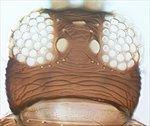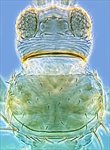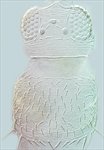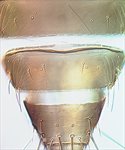
trehernei head

trehernei meso & metanota

trehernei tergites VII-VIII

trehernei male sternites

australis head & pronotum

subnudula head & pronotum

nigropilosus metanotum & tergites

vitticornis meso & metanota

parvispinus tergites VII-IX

tabaci tergites & pleurotergites

vulgatissimus pleurotergites
Generic diagnosis
Female macropterous or micropterous. Head usually wider than long; maxillary palps 3-segmented; compound eyes usually without pigmented facets; ocellar setae I absent, II shorter than III. Antennae 7- or 8-segmented, segment I without paired dorso-apical setae, forked sense cone on segments III and IV usually short. Pronotum with two pairs (rarely 1 or 0) of posteroangular setae, with three or four pairs of posteromarginal setae. Mesonotum with median pair of setae far from posterior margin; campaniform sensilla present or absent. Metanotum striate or reticulate; campaniform sensilla present or absent; median pair of setae at or behind anterior margin. Fore wings with setal row on first vein usually interrupted but complete in some species; clavus with 5 (rarely 6) veinal setae and 1 discal seta. Prosternum with ferna not divided, basantra membranous without setae. Mesosternum with sternopleural sutures complete, furca with spinula. Metasternum without furcal spinula. Tarsi 2-segmented. Tergites with setae S2 usually longer than S3, tergites IV or V–VIII with paired lateral ctenidia; VIII with ctenidia posteromesad to spiracles, usually ending at base of setae S3; tergite VIII posteromarginal comb varying between species, from complete to almost absent. Sternite II with 2 (rarely 3) pairs of marginal setae, III–VII with 3 pairs, sternal discal setae present or absent; pleurotergites II–VII with or without discal setae.
Male generally similar to female but smaller; abdominal sternites III–VII (or VI) each with a circular, oval or transverse pore plate.
Biological data
Members of this genus are known to breed on a wide range of different plant species, some on leaves but many in flowers, and some members of the genus appear to be highly polyphagous.
Distribution data
This genus is found worldwide, although there are no species of Thrips native to the Neotropics.
Nomenclatural data
Thrips Linnaeus, 1758: 457. Type species Thrips physapus Linnaeus, 1758, by subsequent designation, Latreille, 1810.
Almost 300 species are listed in this, the most species-rich genus of Thysanoptera (ThripsWiki, 2020), and over 40 of these are listed from China:
addendus (Priesner, 1933: 53). (Taeniothrips)
alatus Bhatti, 1980: 118.
alius Palmer, 1992: 19.
alliorum (Priesner, 1935: 128). (Taeniothrips)
andrewsi (Bagnall, 1921: 394). (Physothrips)
atactus Bhatti, 1967: 17
atratus Haliday, 1836: 447.
australis (Bagnall, 1915: 592). (Isoneurothrips)
brevicornis Priesner, 1920: 59.
brunneus Ishida, 1936: 67.
carthami Shumsher, 1946: 184.
coloratus Schmutz, 1913: 1013.
extensicornis Priesner, 1934: 276.
flavidulus (Bagnall, 1923: 628). (Physothrips)
flavus Schrank, 1776: 31.
floreus Kurosawa, 1968: 32.
florum Schmutz, 1913: 1003.
formosanus Priesner, 1934: 283.
fuscipennis Haliday, 1836: 448.
garuda Bhatti, 1980: 137.
hawaiiensis (Morgan, 1913: 3). (Euthrips)
himalayanus (Pelikan, 1970: 363). (Taeniothrips)
inferus Chen, 1979: 423.
juniperinus Linnaeus, 1758: 457.
kotoshoi (Moulton, 1928: 300). (Taeniothrips)
major Uzel, 1895: 179.
malloti (Priesner, 1934: 269). (Thrips: Isoneurothrips)
nigropilosus Uzel, 1895: 198.
obscuripes Priesner, 1934: 278.
orientalis (Bagnall, 1915: 593). (Isoneurothrips)
pallidulus Bagnall, 1924: 424.
palmi Karny, 1925: 10.
parvispinus (Karny, 1922: 106). (Isoneurothrips)
pillichi Priesner, 1924: 2.
physapus Linnaeus, 1758: 457.
simplex (Morison, 1930: 12). (Physothrips)
subnudula (Karny, 1926: 208). (Ramaswamiahiella)
tabaci Lindeman, 1889: 61.
trehernei Priesner, 1927: 356.
vitticornis (Karny, 1922: 103). (Physothrips)
vulgatissimus Haliday, 1836: 447.
wedeliae Priesner, 1934: 257.
xenos Bhatti, 1980: 162.
Relationship data
Thripidae sub-family Thripinae: this is a diverse group involving more than 230 genera. This is one of 14 genera considered to comprise the Thrips genus-group (Mound, 2002; Masumoto & Okajima, 2002). All Thrips species lack ocellar setae pair I, and have paired ctenidia on the tergites, with the ctenidia on tergite VIII placed postero-mesad of the spiracles. However, there is great diversity among the species in this genus, in the number of setae on the fore wing first vein, the presence and number of sternal discal setae, and the number of antennal segments.
References
Masumoto M & Okajima S (2002) A revision of the genus Ernothrips Bhatti (Thysanoptera, Thripidae), with description of a new species from Thailand. Entomological Science 5 (1): 19–28.
Mound LA (2002) The Thrips and Frankliniella genus groups: the phylogenetic significance of ctenidia. Pp. 379–386 in Marullo R & Mound LA [eds] Thrips and Tospoviruses: Proceedings of the 7th International Symposium on Thysanoptera. Australian National Insect Collection, Canberra.
Mound LA & Masumoto M (2005) The genus Thrips (Thysanoptera, Thripidae) in Australia, New Caledonia and New Zealand. Zootaxa 1020: 1–64.
Palmer JM (1992) Thrips from Pakistan to the Pacific: a review. Bulletin of the British Museum Natural History (Entomology) 61: 1–76.
ThripsWiki (2020). ThripsWiki - providing information on the World's thrips. <http://thrips.info/wiki/Main_Page>
Zhang HR, Xie YH & Bei YW (2011) Identification key to species of Thrips genus from China (Thysanoptera, Thripidae), with seven new records.Zootaxa 2810: 37–46.
Zhang SM, Wang ZH, Li YJ & Mound LA (2018) One new species, two generic synonyms and eight new records of Thripidae from China (Thysanoptera). Zootaxa 4418 (4): 370–378.
zur Strassen R (2003) Die terebranten Thysanopteren Europas und des Mittelmeer-Gebietes. Die Tierwelt Deutschlands 74: 1–271.